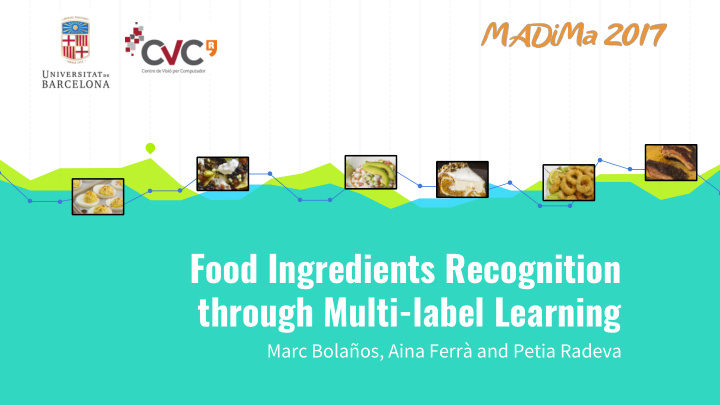



Food Ingredients Recognition through Multi-label Learning Marc Bolaños, Aina Ferrà and Petia Radeva
Motivation
Motivation
Motivation INPUT OUTPUT Computer List of Nutritional Vision Ingredients Composition Algorithm
dishes ingredients Related Work Only one work has been proposed for ingredients recognition. Jingjing Chen and Chong-Wah Ngo. “Deep-based ingredient recognition for cooking recipe retrieval”. In Proceedings of the 2016 ACM on Multimedia Conference, pages 32–41. ACM, 2016.
dishes ingredients Related Work Only one work has been proposed for ingredients recognition. Handicaps of their proposal: - Both dish and ingredients information is needed. Not applicable for never-seen recipes. - Applicable to visible ingredients only. Jingjing Chen and Chong-Wah Ngo. “Deep-based ingredient recognition for cooking recipe retrieval”. In Proceedings of the 2016 ACM on Multimedia Conference, pages 32–41. ACM, 2016.
Conventional CNN for classification Softmax loss Categorical cross-entropy egg
Our proposal: Adaptation for Multi-label recognition Sigmoid mustard loss salt Binary cross-entropy paprika egg
Datasets - Ingredients101 Carrot Cake Baby Back Ribs Dataset complementary to Food101: - 101 classes / dishes - 1000 images per class A recipe for each class was downloaded from resulting in a list of ingredients per class and a total of 446 unique ingredients.
Datasets - Ingredients101 Carrot Cake Baby Back Ribs Dataset complementary to Food101: - 101 classes / dishes - 1000 images per class A recipe for each class was downloaded from resulting in a list of ingredients per class and a total of 446 unique ingredients.
Datasets - Recipes5k New dataset acquired from Around 50 different recipes were downloaded for each class in Food101 together with their respective picture. Resulting in 4,826 images, a list of ingredients per image and a total of 3,213 unique ingredients.
Datasets - Recipes5k Ingredients Simplification Two problems arise when dealing with too many labels: - The amount of training samples needed for learning them. - The ambiguity and minor differences between them. We propose a simplified version by applying a simple removal of overly-descriptive particles (e.g. ’sliced’ or ’sauce’). Simplifying the 3,213 ingredients into 1,013. large eggs → egg lemon zest → lemon meyer lemon juice → lemon unsalted butter → butter boiling water → water
Results - Ingredients101
Results - Ingredients101
Results - Ingredients101
Results - Recipes5k INGREDIENTS SIMPLIFIED
Results - Recipes5k
Results - Recipes5k
Neurons’ Activations
Neurons’ Activations
Neurons’ Activations
Conclusions We have proposed: - Model suitable for ingredients recognition through multi-label learning. - Two datasets for ingredients recognition benchmarking. Advantages of our proposal with respect to the state of the art: - Straightforward model applicable to any highly performing CNN. - Dish/class information is not used for learning. Implying that the ingredients can be inferred from never-seen dishes. - Can directly learn ingredients’ representation from visual appearance. - Can predict invisible ingredients implicitly.
THANK YOU FOR YOUR ATTENTION www.ub.edu/cvub/marcbolanos marc.bolanos@ub.edu
Recommend
More recommend